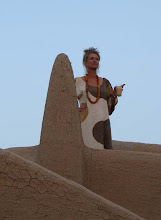
Casablanca.
Like Samarkand and Timbuktu, Casablanca is surely one of the most evocative placenames in the world. ‘Casablanca’ cunjurs up an idealised, palm fringed world of gentle exotism where be-fezzed waiters attend to mysterious beautiful people in dark glasses- probably spies- smoking hubbly bubblies at street cafes.
So what is Casablanca really like? How do we spend our time here during in our little interlude in this legandary city?
There seems to be a strong instinct in the human race to create order and form patterns in our daily existance. Particularly if circumstances are potentially difficult or frightening, routine emerges as a comforting element.
Therefore, Keita’s month of radio therapy here in Casablanca has already become a life which we are living now as if it had always been like this and as if it will always continue.
In the morning I go for 10 lenghts in the pool while Keita is still snoozing. On my way back I pick up our breakfast-
cafe au lait with
pain au chocolat and freshly squeezed orange juice.
Before leaving for the radio therapy session at the clinic, we do half an hour’s physiotherapy which a professional taught me to do when we first arrived. Keita’s legs are retrieving a tiny bit more movement every day. It is my greatest wish that I will bring Keita back to his old mother in Mali with his ability to walk restored...
The taxi journey to the Clinic is always a potentially difficult situation. We arrive at the side of the road by the hotel and we wait for one of the little red Casablanca taxis to take us on the short journey up the hill to the
Clinique Littorale. To their credit the taxi drivers do not shy away from the wheelchair, and they stop easily. It is rather the opposite problem; people are almost too kind, the taxi drivers and the passers-by insist on giving us a hand to lift Keita into the cab. But a wheelchair has many parts that need to be dealt with in a certain sequence, at the same time Keita’s legs need to be put into the cab on the front passenger’s side BEFORE he is lifted in. I always break out in a cold sweat as I try to manage this situation without losing my temper. Keita is of course too kind to tell people to go away, although I know that he is by now quite capable of hoisting himself into the cab unaided. I try my best to defend him from the clumsy well-doers who only yesterday were responsible for causing a big rip in the new khaki combat trousers I bought for him at the GAP in London, thus ruining his day.
Finally, however, even the daily cab trial reaches a conclusion and we arrive, more or less intact, to the
Clinique Littorale, where a cheerful, rotund young porter in red uniform and baby blue plastic hat and clogs takes charge and wheels Keita into the waiting area.
By now we know and greet the other patients, all Moroccan, mostly elderly, in traditional dress and accompanied by their spouses or children. A spirit of camaraderie reigns: smiles of encouragement and exchanges of a few words: ‘ how many sessions have you got left?’ ‘It will be OK, Inshallah’. ‘Amina’. A jolly middle aged woman, the daughter of a man suffering from prostate cancer, always flirts with Keita and jokes with me that I must leave him behind for her...













